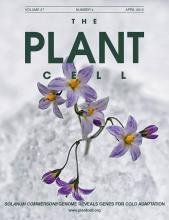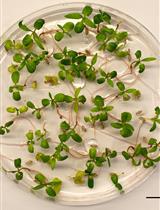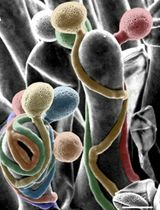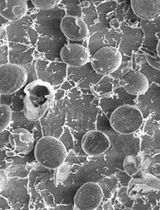- EN - English
- CN - 中文
Examining Autophagy in Plant by Transmission Electron Microscopy (TEM)
利用透射电镜检测植物细胞自噬
发布: 2018年10月20日第8卷第20期 DOI: 10.21769/BioProtoc.3047 浏览次数: 7810
评审: Zhibing LaiXiaohong ZhuangAnonymous reviewer(s)
Abstract
In plants, macroautophagy, here referred as autophagy, is a degradation pathway during which the double-membrane structure named autophagosome engulfs the cargo and then fuses with vacuole for material recycling.
To investigate the process of autophagy, transmission electron microscopy (TEM) was used to monitor the ultrastructure of autophagic structures and identify the cargo during this process due to its high resolution. Compared to other autophagy examination methods including biochemical assays and confocal microscopy, TEM is the only method that indicates the morphology of autophagic structures in nanoscale, which is considered to be one of the best ways to illustrate the morphology of autophagic intermediates and the substrate of autophagy. Here, we describe the autophagy examination assay using TEM in Nicotiana benthamiana leaf cells.
Background
Autophagy is a highly conserved macromolecular degradation pathway in eukaryotes (Dikic, 2017). In plants, autophagy is induced by several stress conditions including starvation, oxidative stress, salt stress and senescence (Doelling et al., 2002; Hanaoka et al., 2002; Liu et al., 2005; Bassham, 2007; Liu and Bassham, 2009; Luo et al., 2017). During autophagy, double-membrane vesicles named autophagosomes form in cytoplasm and transport into the central vacuole, where the outer membrane of autophagosomes fuses with vacuolar membrane. Then the single-membrane structure termed as autophagic body enters into the vacuole lumen and ultimately gets degraded (Ohsumi, 2001; Liu and Bassham, 2012).
Till now, numerous methods for examining autophagy in plants have been established. The frequently used assays are confocal microscopy, electron microscopy and biochemical methods. As for confocal microscopy detection, autophagy marker including ATG8, ATG5 and SH3P2 fused with fluorescent proteins were used to label autophagy related structures (Zhuang et al., 2013; Le Bars et al., 2014; Zhuang and Jiang, 2014; Kliosnky et al., 2016). In addition, fluorescentacidotropic dye such as monodansylcadaverine (MDC) was also used to label autophagic structures in plant cells. Biochemical methods to measure autophagic flux is to detect the ratio of ATG8 and ATG8-PE, or the ratio of GFP-ATG8 and GFP. Nevertheless, TEM is dramatically outstanding among these methods for its high resolution thus provides more legible information of autophagic structure as well as its cargo. Thus, both qualitative and quantitive analysis of autophagy could be performed using TEM observation.
Under TEM observation, autophagosome is distinctly visible as two membrane bilayers which are separated by an electron-translucent aperture (Kliosnky et al., 2016). Meanwhile, it contains cargos for degradation. Generally, during nonselective autophagy, the size of autophagic structures is 0.5-1.5 μm. As for selective autophagy, the size of autophagic structures relies on the specific substrates. Here, we describe the protocol for examining autophagy activity by TEM in Cytoplastic Glyceraldehyde-3-Phosphate (GAPC) silenced plant cells.
Materials and Reagents
- 0.1-10 μl pipette tips (Thermo Fisher Scientific, QSP, catalog number: 104-Q )
- 1-200 μl pipette tips (Thermo Fisher Scientific, QSP, catalog number: 110-B-Q )
- 1-1,000 μl pipette tips (Corning, Axygen®, catalog number: T-1000-B )
- 1.5 ml microcentrifuge tubes
- Toothpick (Yin Sha, catalog number: 918 )
- Grid (Emcn, catalog number: AZH75HH )
- 40 holes flat embedding mold (Emcn, catalog number: DZ10590-40 )
- 4 weeks-old Nicotiana benthamiana plants
- Agrobacterium strain GV3010
- E-64d (Sigma-Aldrich, catalog number: E8640-1MG )
- Paraformaldehyde (Electron Microscopy Sciences, catalog number: 157-8 )
- Glutaraldehyde (Structure Probe, SPI-CHEM, catalog number: 02607-BA )
- Sodium dihydrogen phosphate dehydrate (NaH2PO4•2H2O) (Sigma-Aldrich, catalog number: 1.06342.1000 )
- Disodium hydrogen phosphate dodecahydrate (Na2HPO4•12H2O) (Sigma-Aldrich, catalog number: 04273 )
- Potassium hexacyanoferrate (K3[Fe(CN)6]) (Sigma-Aldrich, catalog number: 702587 )
- OsO4 (Ted Pella, catalog number: 18451 )
- ddH2O
- Uranyl acetate (DEUTSCHL AND LUXEMBURGPRODUZIER TSPE ZIA LCHEMIKALIEN PROD UKTION)
- Lead acetate (Structure Probe, SPI-CHEM, 1161108)
- Ethanol (Sinopharm Chemical Reagent, catalog number: 10009218 )
- Epoxypropane (Sinopharm Chemical Reagent, catalog number: 80059118 )
- 1% (w/v) uranyl acetate in ddH2O and 2% (w/v) uranyl acetate in ddH2O
- DDSA (Structure Probe, SPI-CHEM, catalog number: 02827-AF )
- SPI-PONTM812 (Structure Probe, SPI-CHEM, catalog number: 02659-AB )
- NMA (Structure Probe, SPI-CHEM, catalog number: 02828-AF )
- DMP-30 (Structure Probe, SPI-CHEM, catalog number: 02823-DA )
- HCl (Sinopharm Chemical Reagent, catalog number: 10011008 )
- NaOH (Sinopharm Chemical Reagent, catalog number: 10019762 )
- Trizol reagent (Tiangen)
- RNase-free DNase I (Sigma-Aldrich)
- Oligo(dT)
- TRANScript moloney murine leukemia virus reverse transcriptase (Tiangen)
- Power SYBRGreen PCR master mix (Applied Biosystems)
- Paraformaldehyde-glutaraldehyde Fixative Solution (2%/2.5%), pH 7.2 (see Recipes)
- 0.1 M phosphate buffer (PB), pH 7.2 (see Recipes)
- OsO4-hexacyanoferrate fixative solution (see Recipes)
- 1% (w/v) uranyl acetate (see Recipes)
- 2% (w/v) uranyl acetate (see Recipes)
- 0.2% lead acetate (see Recipes)
- Epon 812 (see Recipes)
- 20 μM E-64d (see Recipes)
Equipment
- Water Purification System (Merck, Milli-Q®, model: Advantage A10 )
- Art knife (FLYING EAGLE, catalog number: 74-S )
- Pincette (Beijing XXBR Technology, catalog number: T5889 )
- Diamond knife (DiATOME, catalog number: DU4535 )
- Eppendorf Research® plus Pipette 0.5-10 μl
- Eppendorf Research® plus Pipette 10-200 μl
- Eppendorf Research® plus Pipette 100-1,000 μl
- Diaphragm vacuum pump (Tianjin Jinteng Experiment Equipment, catalog number: GM-0.50II )
- Shaking incubator (Miulab, catalog number: ES-60 )
- Electronic balance (Sartorius AG)
- Electro-heating standing-temperature cultivator (Tianjin Taisite Instrument, model: DH4000BII )
- Electrothermal constant-temperature dry box (Tianjin Taisite Instrument, model: 202-0AB )
- Ultramicrotome (Leica Microsystems, model: EM UC6 )
- Eyelash pen
- Dyeing machine (Leica Microsystems, model: EM AC20 )
- Electron microscope (Hitachi High-Technologies, model: H-7650 )
- Bio-Rad CFX96 real-time PCR detection system
Procedure
文章信息
版权信息
© 2018 The Authors; exclusive licensee Bio-protocol LLC.
如何引用
Zheng, X., Zhao, C. and Liu, Y. (2018). Examining Autophagy in Plant by Transmission Electron Microscopy (TEM). Bio-protocol 8(20): e3047. DOI: 10.21769/BioProtoc.3047.
分类
植物科学 > 植物生理学 > 新陈代谢
细胞生物学 > 细胞成像 > 电子显微镜
您对这篇实验方法有问题吗?
在此处发布您的问题,我们将邀请本文作者来回答。同时,我们会将您的问题发布到Bio-protocol Exchange,以便寻求社区成员的帮助。
提问指南
+ 问题描述
写下详细的问题描述,包括所有有助于他人回答您问题的信息(例如实验过程、条件和相关图像等)。
Share
Bluesky
X
Copy link













